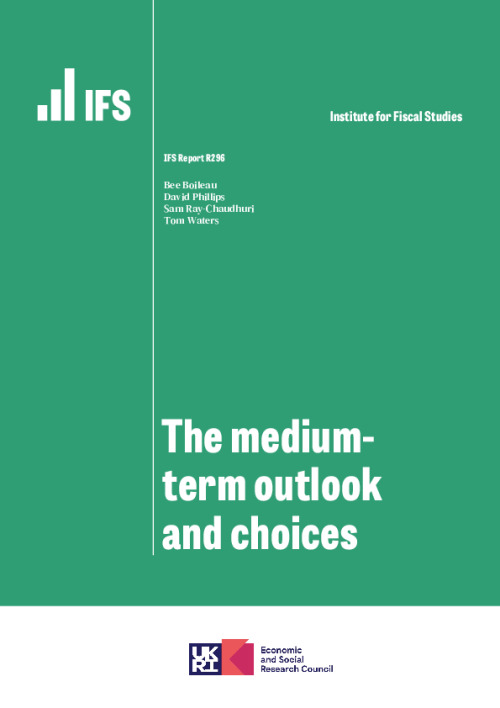This chapter of our second annual Budget Report looks beyond 2024–25 to the medium-term outlook for the Scottish Government’s funding, and the implications of the funding picture for the choices and trade-offs faced when allocating funding between areas of the budget. The Scottish Government had said it would confront those choices alongside the 2024–25 Budget by publishing an update to 2022’s Resource Spending Review. However, with the Deputy First Minister and Finance Minister, Shona Robison, citing the ‘turbulent economic environment’, a decision has been taken to postpone this until the next set of economic and fiscal forecasts from the Scottish Fiscal Commission (SFC) and the publication of the next Scottish Government Medium-Term Financial Strategy (MTFS), expected in the late spring or early summer. Our analysis, presented below and based on current forecasts for UK government funding and devolved tax revenues, suggests that 2025–26 will see a substantial real-terms increase in Scottish Government resource funding. However, 2026–27 onwards is currently forecast to see much smaller increases in resource funding – that could easily be more than entirely absorbed by the NHS and other priority areas, necessitating cutbacks to many other services. A planned cash-terms freeze to capital funding from the UK government, together with Scotland planning to reduce borrowing used for capital purposes (in an attempt to maintain some headroom against its borrowing limits), is set to see capital funding in Scotland fall significantly in real terms over the second half of the 2020s. More funding than is currently pencilled in might be made available by the UK government for both resource and capital purposes, but risks to net revenues from devolved taxes are likely weighed to the downside. The Scottish Government should not bank on significantly more funding becoming available.
Key findings
1. The medium-term outlook for Scottish Government funding will depend on both the funding it receives from the UK government and the net revenue it receives from its own devolved taxes and other income sources. Broadly speaking, current plans imply that UK government funding is set to be highly constrained over the period 2025–26 to 2028–29, as efforts are made to start to bring down the debt-to-GDP ratio. On the other hand, forecasts imply that the net contribution of devolved tax revenues to Scottish Government funding is set to increase substantially, driven by income tax.
2.The UK government has pencilled in 0.8% real-terms increases per year in its overall departmental resource spending limits in the four years from 2025–26 to 2028–29. Capital spending limits are set to be frozen in cash terms, implying real-terms cuts averaging 1.7% a year. The Scottish Government’s block grant funding will depend on how the UK government allocates funding between departments responsible fully or largely for services that are devolved in Scotland (such as the NHS, housing and justice), versus those responsible fully or largely for UK-wide services (such as defence). In the absence of this information, the Scottish Government assumes block grant funding will change by the same percentage rates as the overall resource and capital spending plans. But, because of the way the Barnett formula operates, Scotland will only get a 0.8% a year real increase in its block grant if UK departments responsible for services that are devolved in Scotland see their budgets increase at a rate faster than this.
3.SFC forecasts for devolved tax revenues and Office for Budget Responsibility (OBR) forecasts for the associated block grant adjustments imply the net contribution of devolved taxes to the Scottish budget will increase by almost 6% a year in real terms between 2024–25 and 2028–29. This is driven by income tax, which is forecast to contribute a net £2.3 billion in 2028–29, up from a forecast £1.4 billion next year. The higher net contribution of income tax reflects the fact that the SFC is forecasting faster earnings growth for Scotland than the OBR is forecasting for the UK as a whole (explaining around £500 million of this increase), and Scotland’s generally higher marginal income tax rates, which mean each additional pound of earnings growth generates more revenue (explaining much of the remaining increase).
4. Despite only small increases in UK government funding, the Scottish Government’s overall resource funding is set to increase by 2.9% in real terms in 2025–26, with the amount available for devolved public services (after accounting for forecast spending on devolved social security benefits) increasing by 2.2% in real terms. In part, this reflects forecast year-on-year growth in the net income tax revenue position. But more important is that the SFC now thinks its initial forecasts for Scottish income tax revenue performance in 2022–23 were pessimistic, so is predicting a positive £732 million forecast reconciliation payment in 2025–26 when final revenue out-turn data are available.
5.The picture for 2026–27 onwards is much tougher, despite a slight uptick in growth in funding from the UK government. In part, this reflects a slight slowdown in the improvement in the net income tax position, which will contribute an average of 0.3 percentage points to funding growth each year, down from 0.7 percentage points in 2025–26. However, more important is the fact that reconciliations for past income tax forecast errors drop out of the system (as forecast errors only arise as forecasts are updated after budgets have already been set). As a result, the growth in resource funding available for public services in 2026–27, 2027–28 and 2028–29 is projected to average just 0.6% per year in real terms. To smooth out growth since 2024–25, the Scottish Government could place some of the £732 million that is expected to be received in 2025–26 into reserves for drawdown in these later years.
6. Capital funding is projected to fall by 16% in real terms between 2024–25 and 2028–29. This is a result of the cash freeze in UK government capital funding and a reduction in capital borrowing by the Scottish Government, as it seeks to retain some modest ‘headroom’ against its total debt limits to respond to unexpected cost overruns. The Scottish Government could make additional capital funding available, but only by reducing the amount available for day-to-day (resource) purposes.
7. There is significant uncertainty around these projections. On the one hand, the spending plans pencilled in by the UK government are very tight and, on reasonable assumptions, could see funding for many unprotected areas cut by over 3% a year in real terms. Given this, and the fact that the run-ups to both the 2015 and 2021 multi-year Spending Reviews saw top-ups to spending plans, it might seem more likely than not that block grant funding from the UK government will be higher than currently assumed. On the other hand, the SFC highlights how risks related to net income tax revenues weigh to the downside. This is because its relatively fast earnings growth forecasts for Scotland are likely to reflect, at least to some extent, a different view about UK-wide earnings growth compared with the OBR’s, rather than any Scotland-specific factor. If so, this will either depress tax revenues (if the OBR is correct) or inflate the BGA (if the SFC is correct), both of which would reduce the contribution of income tax revenues to future budgets.
8. Under the SFC and Scottish Government’s existing funding projections, if health funding were increased by an average of 2.3% a year in real terms (the rate assumed as needed to maintain existing service standards in the most recent Medium-Term Financial Strategy) and funding for local government held flat in real terms, funding available for other services would be approximately 1% lower in real terms in 2028–29 than in 2024–25. If health funding were increased by an average of 3.3% a year in real terms (in line with estimates from IFS researchers of the cost of the English NHS’s long-term staffing plan) and funding for local government increased by 1% a year in real terms, Scotland would see funding for ‘unprotected’ services fall by 12% in real terms between 2024–25 and 2028–29.
9.If additional UK government funding is forthcoming, these trade-offs would be eased. For example, if an additional £1 billion in UK government funding were made available in 2028–29, then 2.3% real-terms increases in health funding per year and a flat real settlement for local government would be consistent with a 7.5% increase in funding for other services by 2028–29; under 3.3% and 1% real-terms increases for health and local government respectively, the cut to ‘unprotected’ services would be reduced to 4%.
10. On the other hand, if the net income tax revenue position increases by £1 billion less than expected, the challenges would be substantially tougher. For example, 2.3% real-terms increases in health funding per year and flat funding for local government would imply real-terms cuts of 9% to unprotected services by 2028–29; 3.3% real-terms increases in health funding and 1% real-terms increases in funding for local government per year would entail cuts of 21% in real terms by 2028–29.













